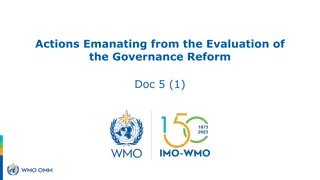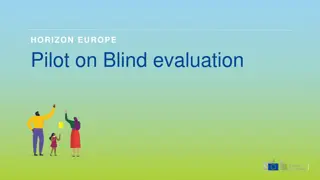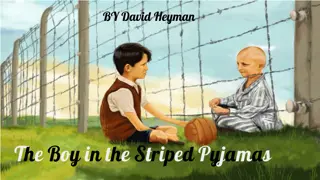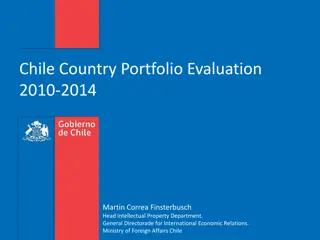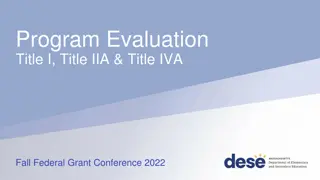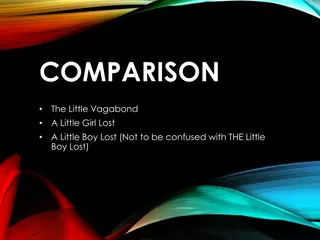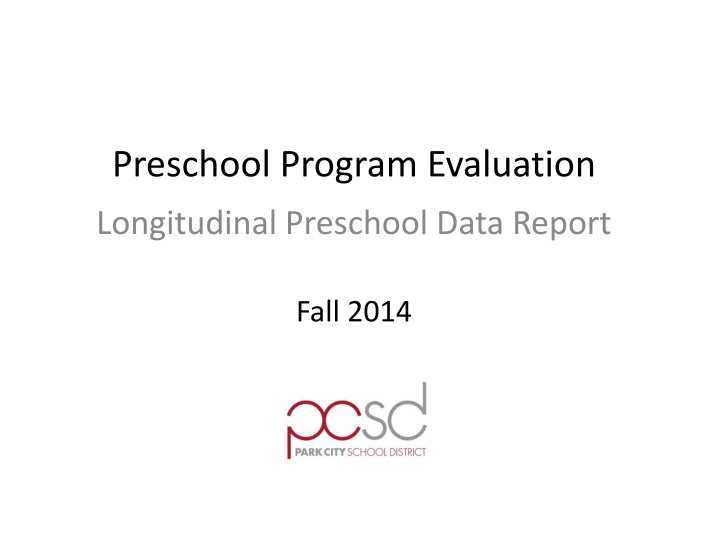
Preschool Program Evaluation Longitudinal Data Report Fall 2014
Explore the longitudinal data report for the Fall 2014 preschool program evaluation, including demographics, Hispanic representation, and effectiveness evaluation at different levels. This report delves into student progress, continued performance, and comparison to peers throughout the preschool and early elementary years, providing insights into the program's impact on student development.
Download Presentation

Please find below an Image/Link to download the presentation.
The content on the website is provided AS IS for your information and personal use only. It may not be sold, licensed, or shared on other websites without obtaining consent from the author. If you encounter any issues during the download, it is possible that the publisher has removed the file from their server.
You are allowed to download the files provided on this website for personal or commercial use, subject to the condition that they are used lawfully. All files are the property of their respective owners.
The content on the website is provided AS IS for your information and personal use only. It may not be sold, licensed, or shared on other websites without obtaining consent from the author.
E N D
Presentation Transcript
Preschool Program Evaluation Longitudinal Preschool Data Report Fall 2014
Preschool Demographics Over 3 Years 2011 2012 N (%) 182 59 (31) 51 (28) 46 (25) 9 (5) 62 16 (25) 15 (24) 12 (19) 3 (5) --- 120 43 (37) 36 (31) 34 (28) 6 (5) --- --- 2012 2013 N (%) 171 63 (37) 50 (29) 47 (28) 10 (6) 74 26 (36) 19 (26) 19 (26) 4 (5) 2 (3) 97 37 (39) 31 (33) 28 (29) 6 (6) 4 (4) 49 (51) 2013 2014 N (%) 207 80 (39) 58 (28) 52 (25) 6 (3) 71 22 (31) 16 (23) 14 (20) 2 (3) 3 (5) 136 58 (45) 42 (33) 38 (28) 4 (3) 5 (4) 62 (46) 2014 2015 N (%) 203 67(33) 40(20) 36(18) 13(6) 76 15 (20) 6 (8) 6 (8) 7(10) -- 127 52 (41) 34 (27) 30 (24) 6(5) -- -- TOTAL Hispanic Low-Income Hispanic & Low Income Special Education 3 Year Olds Hispanic Low-Income Hispanic & Low Income Special Education Attended Pre-k 3 twice 4 Year Olds Hispanic Low-Income Hispanic & Low Income Special Education Attended Pre-k 4 twice Attend as 3 and 4 year old Note. All preschool student demographics, frequencies, and analyses include only those who were enrolled in PCSD preschool program for at least 2/3 of the school calendar
District, Elementary, and Preschool Hispanic Representation 39% 37% 32% 31% 26% 26% 24% 24% 21% 20% 19% 19% 2011-2012 2012-2013 2013-2014 2014-2015 District Elementary Preschool
Evaluating Effectiveness at Three Levels 1. Student progress during Preschool 2. Preschool students continued performance in Kindergarten 2nd Grade 3. Preschool students performance in Kindergarten 2nd Grade in comparison to their peers Note. All preschool student demographics, frequencies, and analyses include only those who were enrolled in PCSD preschool program for at least 2/3 of the school calendar and do not include students who have been identified as special education except for specific Special Education Charts.
1. Student Progress During Preschool 2012 2015 BOY EOY EPS Essential Preschool Skills IGDI Individual Growth and Development Indicators
Median EPS TOTAL Scores Over Time 3 YR Olds EPS 100 80 60 40 20 0 BOY MOY EOY BOY MOY EOY BOY MOY EOY BOY MOY EOY 2011-2012 2012-2013 2013-2014 2014-2015 Target Hispanic Non-Hispanic 4 YR Olds EPS 200 150 100 50 0 BOY MOY EOY BOY MOY EOY BOY MOY EOY BOY MOY EOY 2011-2012 2012-2013 2013-2014 2014-2015 Target Hispanic Non-Hispanic *Indicates Statistically Significant Group Mean Difference from the Previous Measurement, p=.05 Indicates significant differences between comparison groups Note. All preschool student demographics, frequencies, and analyses include only those who were enrolled in PCSD preschool program for at least 2/3 of the school calendar and do not include students who have been identified as special education except for specific Special Education Charts.
Median IGDI TOTAL Scores Over Time 3 YR Olds Picture Naming 30 25 20 15 10 5 0 BOY MOY EOY BOY MOY EOY BOY MOY EOY BOY MOY EOY 2011-2012 2012-2013 2013-2014 2014-2015 Target Hispanic Non-Hispanic 4 YR Olds Picture Naming 35 30 25 20 15 10 5 0 BOY MOY EOY BOY MOY EOY BOY MOY EOY BOY MOY EOY 2011-2012 2012-2013 2013-2014 2014-2015 Target Hispanic Non-Hispanic *Indicates Statistically Significant Group Mean Difference from the Previous Measurement, p=.05 Indicates significant differences between comparison groups Note. All preschool student demographics, frequencies, and analyses include only those who were enrolled in PCSD preschool program for at least 2/3 of the school calendar and do not include students who have been identified as special education except for specific Special Education Charts.
Median IGDI TOTAL Scores Over Time 4 YR Olds Rhyming 19 14 9 4 -1 BOY MOY EOY BOY MOY EOY BOY MOY EOY BOY MOY EOY 2011-2012 2012-2013 2013-2014 2014-2015 Target Hispanic Non-Hispanic 4 YR Olds Alliteration 13 11 9 7 5 3 1 -1 BOY MOY EOY BOY MOY EOY BOY MOY EOY BOY MOY EOY 2011-2012 2012-2013 2013-2014 2014-2015 Target Hispanic Non-Hispanic *Indicates Statistically Significant Group Mean Difference from the Previous Measurement, p=.05 Indicates significant differences between comparison groups Note. All preschool student demographics, frequencies, and analyses include only those who were enrolled in PCSD preschool program for at least 2/3 of the school calendar and do not include students who have been identified as special education except for specific Special Education Charts.
Median EPS TOTAL Scores Over Time for Special Education 3 YR Olds 100 80 60 40 20 0 BOY MOY EOY BOY MOY EOY BOY MOY EOY BOY MOY EOY 2011-2012 (N=3) 2012-2013 (N=4) 2013-2014 (N=3) 2014-2015 (N=8) Target Special Education 4 YR Olds 200 150 100 50 0 BOY MOY EOY BOY MOY EOY BOY MOY EOY BOY MOY EOY 2011-2012 (N=6) 2012-2013 (N=6) 2013-2014 (N=4) 2014-2015 (N=6) Target Special Education Note. All preschool student demographics, frequencies, and analyses include only those who were enrolled in PCSD preschool program for at least 2/3 of the school calendar.
2. Preschool students continued performance in Kindergarten, 1st, and 2nd Grade Three Preschool Cohorts 1. Preschool in 11-12 through 2nd Grade in 14-15 N = 80 2. Preschool in 12-13 through 1st Grade in 14-15 N = 75 3. Preschool in 13-14 through Kindergarten in 14-15 N = 135
Dynamic Indicators of Basic Early Literacy Skills DIBELS Early identification of students in need of support Helpful in identifying effectiveness of system Note. DIBELS is currently the only assessment measure collected for Kindergarten 2nd Grade. So the following analyses only include this one data point. Beginning in 3rd grade, students begin taking standardized state testing which will provide additional content progress measurements.
PCSD Preschoolers Currently in Kindergarten % at DIBELS Benchmark 18% 11% 71% BOY-K MOY-K EOY-K 2014-2015 BENCHMARK STRATEGIC INTENSIVE Median DIBELS Scores 150 100 50 0 BOY-K MOY-K EOY-K 2014-2014 Target Hispanic Non-Hispanic *Indicates Statistically Significant Group Mean Difference from BOY Measurement, p=.05 Indicates significant differences between comparison groups Note. All preschool student demographics, frequencies, and analyses include only those who were enrolled in PCSD preschool program for at least 2/3 of the school calendar and do not include students who have been identified as special education except for specific Special Education Charts.
PCSD Preschoolers Currently in 1st Grade % at DIBELS Benchmark 4% 6% 7% 10% 18% 6% 12% 9% 87% 86% 83% 73% BOY-K MOY-K EOY-K BOY-1 MOY-1 EOY-1 2013-2014 2014-2015 BENCHMARK STRATEGIC INTENSIVE Median DIBELS Scores 200 150 100 50 0 BOY-K MOY-K EOY-K BOY-1 MOY-1 EOY-1 2013-2014 2014-2015 Target Hispanic Non-Hispanic *Indicates Statistically Significant Group Mean Difference from BOY Measurement, p=.05 Indicates significant differences between comparison groups Note. All preschool student demographics, frequencies, and analyses include only those who were enrolled in PCSD preschool program for at least 2/3 of the school calendar and do not include students who have been identified as special education except for specific Special Education Charts.
PCSD Preschoolers Currently in 2nd Grade % at DIBELS Benchmark 2% 4% 11% 12% 10% 16% 18% 18% 12% 10% 17% 13% 12% 13% 88% 84% 78% 71% 71% 71% 69% BOY-K MOY-K EOY-K BOY-1 MOY-1 EOY-1 BOY-2 MOY-2 EOY-2 2012-2013 2013-2014 2014-2015 BENCHMARK STRATEGIC INTENSIVE Median DIBELS Scores 250 200 150 100 50 0 BOY-K MOY-K EOY-K BOY-1 MOY-1 EOY-1 BOY-1 MOY-1 EOY-1 2012-2013 2013-2014 2014-2015 Target Hispanic Non-Hispanic *Indicates Statistically Significant Group Mean Difference from BOY Measurement, p=.05 Indicates significant differences between comparison groups Note. All preschool student demographics, frequencies, and analyses include only those who were enrolled in PCSD preschool program for at least 2/3 of the school calendar and do not include students who have been identified as special education except for specific Special Education Charts.
3. Preschool students performance in Kindergarten, 1st, and 2nd Grade compared to their peers 1. Current Kindergarteners N = 299 135 attended PCSD Preschool, 57 attended PCSD Preschool as 3 and 4 year olds 101 identified as Hispanic, 52 identified as Low Income, 48 were identified as both Hispanic and Low Income. 110 are enrolled in Full Day Kindergarten of those, 43 attended PCSD Pre-K, 63 are Hispanic, and 27 are Low Income. 2. Current 1st Graders N = 307 75 attended PCSD Preschool, 37 attended PCSD Preschool as 3 and 4 year olds 68 identified as Hispanic, 62 identified as Low Income, 57 were identified as both Hispanic and Low Income. 2. Current 2nd Graders N = 359 80 attended PCSD Preschool 91 identified as Hispanic, 93 identified as Low Income, 80 were identified as both Hispanic and Low Income.
Former Preschoolers Currently in Kindergarten Compared to Peers % at DIBELS Benchmark 71% 68% BOY-K MOY-K EOY-K 2014-2015 PCSD Preschool No PCSD Preschool Median DIBELS Scores 140 120 100 80 60 40 20 0 BOY MOY MOY 2014-2015 Target PCSD Preschool No PCSD Preschool *Indicates Statistically Significant Group Mean Difference from BOY Measurement, p=.05 There were no significant group mean differences for BOY or MOY Note. All preschool student demographics, frequencies, and analyses include only those who were enrolled in PCSD preschool program for at least 2/3 of the school calendar and do not include students who have been identified as special education.
Former Preschoolers Currently in 1st Grade Compared to Peers % at DIBELS Benchmark 90% 87% 86% 85% 82% 77% 74% 70% BOY-K MOY-K EOY-K BOY-1 MOY-1 EOY-1 2013-2014 2014-2015 PCSD Preschool No PCSD Preschool Median DIBELS Scores 200 150 100 50 0 BOY-K MOY-K EOY-K BOY-1 MOY-1 EOY-1 2013-2014 2014-2015 Target PCSD Preschool No PCSD Preschool *Indicates Statistically Significant Group Mean Difference from BOY Measurement, p=.05 There were no significant group mean differences for BOY or MOY Note. All preschool student demographics, frequencies, and analyses include only those who were enrolled in PCSD preschool program for at least 2/3 of the school calendar and do not include students who have been identified as special education.
Former Preschoolers Currently in 2nd Grade Compared to Peers % at DIBELS Benchmark 90% 88% 84% 83% 81% 75% 74% 74% 73% 72% 71% 69% 65% 64% BOY-K MOY-K EOY-K BOY-1 MOY-1 EOY-1 BOY-2 MOY-2 EOY-2 2012-2013 2013-2014 2014-2015 PCSD Preschool No PCSD Preschool Median DIBELS Scores 250 200 150 100 50 0 BOY-K MOY-K MOY-K BOY-1 MOY-1 EOY-1 BOY-2 MOY-2 EOY-2 2012-2013 2013-2014 2014-2015 Target PCSD Preschool No PCSD Preschool *Indicates Statistically Significant Group Mean Difference from BOY Measurement, p=.05 There were no significant group mean differences for BOY or MOY Note. All preschool student demographics, frequencies, and analyses include only those who were enrolled in PCSD preschool program for at least 2/3 of the school calendar and do not include students who have been identified as special education.
Former Hispanic Preschoolers Compared to their peers % at DIBELS Benchmark 83% 81% 79% 73% 71% 67% 65% 65% 62% 61% 56% 50% 49% 27% BOY MOY EOY BOY MOY EOY BOY MOY EOY Kindergarten 1st Grade 2nd Grade PCSD Preschool Hispanics No PCSD Preschool Hispanics Median DIBELS Scores 250 200 150 100 50 0 BOY MOY EOY BOY MOY EOY BOY MOY EOY Kindergarten 1st Grade 2nd Grade Target PCSD Preschool Hispanics No PCSD Preschool Hispanics *Indicates Statistically Significant Group Mean Difference from BOY Measurement, p=.05 There were no significant group mean differences for BOY or MOY Note. All preschool student demographics, frequencies, and analyses include only those who were enrolled in PCSD preschool program for at least 2/3 of the school calendar and do not include students who have been identified as special education.
Former Special Education Preschoolers Compared to their peers % at DIBELS Benchmark 100% 75% 75% 71% 71% 67% 67% 57% 54% 50% 50% 38% 29% 25% BOY MOY EOY BOY MOY EOY BOY MOY EOY Kindergarten 1st Grade 2nd Grade PCSD Preschool Spec Edu No PCSD Preschool Spec Edu Median DIBELS Scores 300 250 200 150 100 50 0 BOY MOY EOY BOY MOY EOY BOY MOY EOY Kindergarten 1st Grade 2nd Grade Target PCSD Preschool Spec Edu No PCSD Preschool Spec Edu *Indicates Statistically Significant Group Mean Difference from BOY Measurement, p=.05 There were no significant group mean differences for BOY or MOY Note. All preschool student demographics, frequencies, and analyses include only those who were enrolled in PCSD preschool program for at least 2/3 of the school calendar and do not include students who have been identified as special education.

